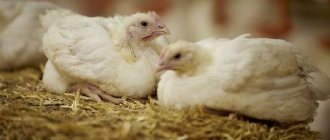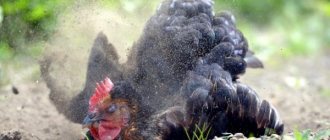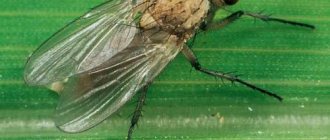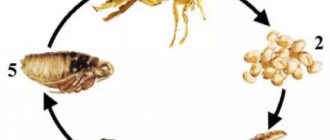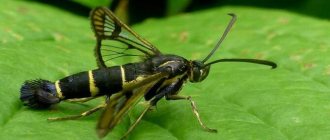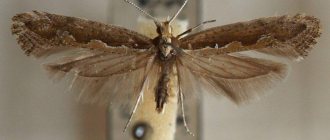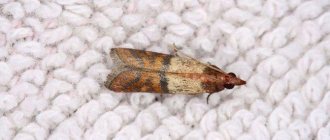Poultry in the summer is often attacked by ectoparasites. Feather mites in chickens are a problem that every farmer may face. Those who have just begun to engage in poultry farming should know that laying hens are attacked by different types of skin parasites, including the scabies mite. It is important to learn to recognize signs of chicken infection at the initial stage, because productivity indicators depend on this.
Feather mite in chickens
How dangerous are parasites for chickens?
Scabies, blood-sucking, and other types of mites that parasitize chickens bother poultry more than fleas or lice eaters. Dangerous ectoparasites cause severe exhaustion, disrupt the barrier function of the skin, worsen the condition of the feathers, and at the same time are carriers of many deadly infections.
Ticks are widespread in nature and are active in the warm season. They feed on blood and elements of cellular structures. Parasites live on birds' legs, in feather pouches, feather follicles, and in the upper and deep folds of the epidermis.
In domestic chickens, mites cause the following diseases:
- Knemidocoptosis of the body (body scabies). The disease is caused by ticks of the genus Knemidocoptes. They live in the deep folds of the epidermis. They provoke inflammation and destroy dermal cells. A characteristic sign is the appearance of small nodules on the body. This type of mite can infect the legs.
- Epidermoptosis (skin-eaten scabies). Caused by the epidermoptes mite. It parasitizes feather follicles and fluff. It provokes feather loss and acute inflammation in various structures of the dermis.
- Cytolichiosis, cytoditosis, sternostomosis. The disease is caused by a tick from the genus Cystodis. It parasitizes the bronchi and upper respiratory tract of birds.
- Malophagosis. The disease is caused by ticks. They live in the subfeather space, under the wings, and infect the feather spine.
Chicken infected with feather mites
Ixodid mites, which are ubiquitous, do not pose a particular danger to chickens. Parasites feed on blood. In rare cases, females attack a bird, but after drinking blood, they fall off. If you find an ixodid tick on the body of a bird, do not panic. They are not dangerous for poultry.
Symptoms of mites in laying hens and broilers
Tick identification and symptoms.
The first step is to monitor the chicken coop. In a problem poultry house, parasites are localized in crevices and on different surfaces. In this case, to visualize them, it is enough to illuminate the suspicious place with a flashlight.
In the evening, the bedding material is also subject to study: it is laid out in small quantities on a light surface (you can use an A4 sheet and inspected under a bright lamp.
You can talk about tick infestation when:
- Birds behave unnaturally;
- the bird stops gaining weight or becomes skinny;
- there are bare areas of skin. This is the result of feathers falling out during the process of getting rid of bloodsuckers on their own. Claws and beak are used.
The alarm should be sounded if there are numerous wounds, the bird’s reluctance to move, heavy breathing, coughing (a rare occurrence) and refusal to feed.
The saliva of ticks contains compounds that disrupt the functioning of the nervous system. The bite site turns red and the temperature rises.
Signs of chicken infection
You can tell that a bird is infected with mites based on several signs. Parasites can be seen in different places in the poultry house - on the walls, under perches, in cracks in the floor.
If the bird has become inactive, experiences severe itching, egg production has decreased, young animals are not gaining weight well, the condition of the plumage has worsened, or bald spots have appeared on the body, it is most likely that the chickens are infected with mites.
Pay attention to the behavior of your feathered charges. If hens begin to clean their feathers more often, pluck feathers under their wings, in the cloaca area, and constantly take “sand” baths, this may also indicate an infection with feather mites and scabies mites.
Ticks in the chicken coop
Other symptoms of mites in chickens:
- weakness, apathy;
- wounds, scratches, sores on the body;
- dry frequent cough, shortness of breath;
- pallor of mucous membranes, comb, earrings;
- lack of egg production in laying hens;
- weight loss;
- refusal to eat, increased thirst.
Upon closer examination, you can see small red or black spots, small grains, droplets of blood on the feathers, body of birds or on the walls of chicken coops and perches.
You can detect a tick by placing material from a nest, perch, or chicken coop on a white sheet of paper and examining it in bright light. It is best to collect material in the evening, at night.
Acarymorpha mite
Having determined that a bird is infected with ticks, you need to immediately get rid of the blood-sucking parasites, since under favorable conditions they multiply very quickly, and the infestation can become a real problem, which will result in large financial losses. Even if the mite lives on only one chicken, over time, if the bird is not cured and the ectoparasites are not removed, the entire chicken population will be infected.
Causes of mites in poultry houses
It is impossible to completely eliminate the possibility of parasites entering the chicken coop. Mites enter the poultry house in several ways:
- when moving newly arrived chickens that were infected;
- a farmer can carry parasites on his clothes or with equipment;
- when healthy birds come into contact with sick ones while walking.
Ticks multiply quickly and infect the entire population. The spread and activation of parasites is facilitated by warm weather and high humidity.
Red chicken mites
The red chicken mite, which got its name because of the color of its small body, belongs to the class of blood-sucking parasites. It is a carrier of various viruses, bacteria, and spreads the causative agent of cholera, typhoid, borreliosis, spirochitosis.
The body length of parasites does not exceed 0.6–0.7 mm. The color of the body is dark brown, brownish-red. After the blood tick drinks blood, the body turns purple. The female is capable of laying 15–20 eggs per day. The maximum period of activity for red chicken mites is from May to mid-October. Parasites have a complex life cycle, which includes several larval stages and depends on environmental conditions. Its duration is 6–13 days.
Red chicken mite
The blood-sucking parasite prefers a warm, humid microclimate. Lives in damp, damp, poorly ventilated areas. The maximum accumulation of chicken mites can be seen in the litter. At the same time, detecting parasites is not so difficult. Some chicken mites are constantly on the surface of the body of an infested bird, others live in chicken coops, poultry houses, hiding in the litter, under perches, in cracks on walls, floors, and at nightfall they leave their shelter in search of a new victim.
Advice! If the chickens are reluctant to enter the chicken coop, set up new nesting places, and experience severe itching, these are clear signs that the bird is infected with red mites.
The red chicken mite feeds on blood, biting and damaging the skin. The bird experiences discomfort, itching, and shows anxiety. The condition of the feathers greatly deteriorates, the immune system weakens, and anemia develops, which can cause the death of infested birds.
Dangerous pests enter farms with newly arrived chickens. Parasites can spread through household items and equipment. Most often, red ticks live in rooms and farmsteads with unsatisfactory sanitary conditions.
Infection is facilitated by high humidity in poultry houses, the absence of sand baths for chickens, and a high density of birds in a limited space. It is worth noting that red chicken mites are dangerous to humans. They cause severe itching and allergies.
When day-old chicks are placed in poultry houses with mites, a high mortality rate is observed. The chicks die from exhaustion and anemia within 5–7 days.
Severe infestation of chicken with chicken mites
Prevention of chicken mite infection
In order to prevent the invasion of small bloodsuckers into the chicken coop, it is necessary:
- Conduct seasonal inspections of the premises for the presence of parasites;
- constantly remove garbage and change fillers;
- keep chicken breeding areas dry and tidy;
- treat the chicken coop with diesel fuel, cover the walls and floor with lime:
- use diatomaceous earth to prevent the mites from returning .
To achieve the best effect, after an infection it is necessary to treat the birds twice a week with approved insecticides, and sprinkle the feathers with special powders, such as diatomaceous earth .
Chicken mites that infect nails and bird feathers
In addition to the red chicken mite, feather mites and chicken acariform mites are a danger to domestic chickens, especially small chickens and young birds.
The feather mite in chickens lives on the feather shaft, in the hole, and feeds on circulating blood, which over time leads to the gradual destruction of the feather and deterioration of the plumage. If the infection is severe, chickens may be left with no feathers at all. Unfortunately, at the moment, no effective treatment for feather mites in chickens has been developed.
Feather mites infect the feathers of birds. Feathers become brittle
Acariform mites in chickens provoke knemidocoptosis (leg scabies), to which roosters are more susceptible than hens. The disease is also known as calcareous foot. It develops slowly, so manifestations may not be noticed immediately.
A characteristic sign by which it can be determined that a bird is infected with this type of parasite is the thickening of the stratum corneum of the skin on the legs. The phalanges of the fingers are completely covered with a bluish coating. Severe infection can lead to deformation of the limbs, so sick chickens should be treated immediately after the first symptoms appear.
Important! The parasite lives under the horny scales on the legs of domestic and wild birds. All stages of its development occur on the host. In the external environment, under favorable conditions, there is no more than 10 days. In breeds of chickens that have feathering on their legs, leg scabies is rarely diagnosed.
Infection with leg scabies
If a bird is infected with leg scabies, the sick chicken has difficulty moving and becomes inactive. Dense gray growths are noticeable on the paws. The skin of the legs becomes lumpy. Pathological exudate accumulates under the scales. Over time, if treatment is not started, the scabies mite causes deformation of the limbs.
Methods for diagnosing parasites
You can diagnose ticks visually by examining the places where the insects live:
- Mites that settle in the holes of feathers. Most often they are located under the wings on the neck, in the area of the eyes and beak. When affected, the chicken sharply loses weight and egg production decreases. Bald spots are also observed on the body.
- A microscopic mite is almost impossible to notice. It is localized throughout the body. Manifestations can be noticed after 2-3 months, when bumps appear on the paws and the fingers become deformed. Before this, the bird behaves restlessly, as it experiences constant itching and discomfort.
- Red tick. More often than others, it affects the body of a chicken. You can notice it when looking through the feathers, it will run across the skin. The check is done in the evening. There will also be bite wounds on the skin.
See also
Description of broiler diseases and causes, symptoms and treatment methodsRead
Treatment
Birch tar is used to treat chicken acariform mites on the legs of poultry. It is heated to a temperature of 40 degrees, poured into a deep bath and the chicken is placed in the solution up to the hock joint. You can simply treat the parasite-affected surface of the leg with tar, using a soft brush, at intervals of 6–7 days.
Birch tar kills mites on chicken legs
Advice! If the mite lives on the legs of chickens, use a solution of Trichlorometaphos or a mixture of birch tar and kerosene in a 1:1 ratio.
If chickens are infected with scabies mites that live on their legs, the parasites can be removed using acaricidal-insecticidal agents of complex action in drops, solutions, and aerosols. They are simply rubbed into the affected skin several times at intervals of 2-3 days.
Danger and methods of protecting people
Not all ticks are dangerous to humans. Ixodid ticks are carriers of Lyme Borelliosis and tick-borne encephalitis. For pests to enter the human bloodstream, direct contact through the blood is necessary. If there is a population of mites in the chicken coop, it must be destroyed using insecticides.
Persian ticks also carry salmonellosis. It causes disease in birds. If you do not notice the symptoms immediately and eat meat or eggs from an infected bird, then a serious infectious disease will develop in the human body. To prevent this, you need to thoroughly heat-treat chicken meat and eggs.
Effective Methods for Cleaning a Chicken Coop
The main control method that will allow the removal of ticks from poultry is complex disinfection, decontamination of the poultry house, cages, and premises in which the poultry is kept. Treat walls, floors, perches, ceilings, and equipment with insecticidal-acaricidal solutions and special chemicals. Wash feeders and drinking bowls thoroughly. Replace the bedding.
Floors, walls, and perches in chicken coops can be treated with boiling water or a blowtorch. To prevent ticks in the poultry house, you can hang wormwood, mint, tomato, potato tops, parsley, onions, and garlic in the corners. The aromas of these plants repel not only chicken mites, but also other ectoparasites.
For decarification you can use:
- cyodrine 0.5%;
- dicresol 0.25%;
- karbofos;
- chlorophos 1–2%;
- trichlorometaphos 0.5–1%;
- DDVF 0.25–0.5%;
- neocidol 0.25–0.5%.
Chlorophos is used to disinfect poultry houses
Important! If a bird is affected by red or Persian mites, the poultry houses are treated two to three times with an interval of 3–6 days.
Examine the chickens carefully. If there are wounds or scratches on the body, treat the affected areas with antiseptic solutions. The affected areas can be lubricated with vegetable oil, wound healing ointments, and liniments.
There are many effective acaricidal agents on the market to combat chicken mites. To get rid of parasites, veterinarians recommend using for chickens:
- Sevin (powder).
- Ecoflix (oily liquid).
- Extrasol M (aerosol).
- Pyrethrum.
- Promectin.
- Ectomin (emulsion).
- Spray with pyremethrin EC (new generation insecticide).
Acaricide against ticks for birds
In case of severe infestation, ticks will have to be removed in several approaches. Treatments are carried out at intervals of 5–10 days, depending on the product used.
Before use, carefully read the instructions for the drug. When choosing an insecticide-acaricide, be sure to consult a veterinarian. Some drugs are strictly forbidden to be used for treatments, since their active substances accumulate in eggs and meat.
In the fight against chicken mites, you can use folk remedies. Add wood ash to sand baths. By cleaning the feathers in this mixture, the bird removes parasites from the body. Sand baths with ash are also a good method of preventing chickens from becoming infected with mites. Do not forget to periodically change the composition of the “dusty” baths.
Preventing tick infestations
Ectoparasites are rarely found in poultry houses where farmers regularly clean them. It is important to keep the room clean and well ventilated during the spring and summer. Inside you need to install a bath with sand and wood ash. Chickens, wallowing in it, independently treat their feathers and skin, which serves to prevent infection by mites.
It is important to regularly change litter and disinfect the poultry house. Walls and ceilings are usually treated with lime; it kills not only ticks, but also various infections. Equipment is washed weekly and scalded with boiling water. If an infected individual is discovered, it is necessary to separate it from its neighbors. Only after treatment is completed can the chicken return to its relatives.
Attention! Laying hens and chicks new to the farm are quarantined to avoid infection of the livestock.
Feather mites and other types of skin parasites are very dangerous. They contribute to the spread of infections that can kill livestock. Having discovered the first signs of infection in one or more laying hens, do not hesitate. Sick individuals are immediately removed and treated; the rest should be examined by a veterinarian. The chicken coop and equipment are treated with insectoacaricidal solutions.
